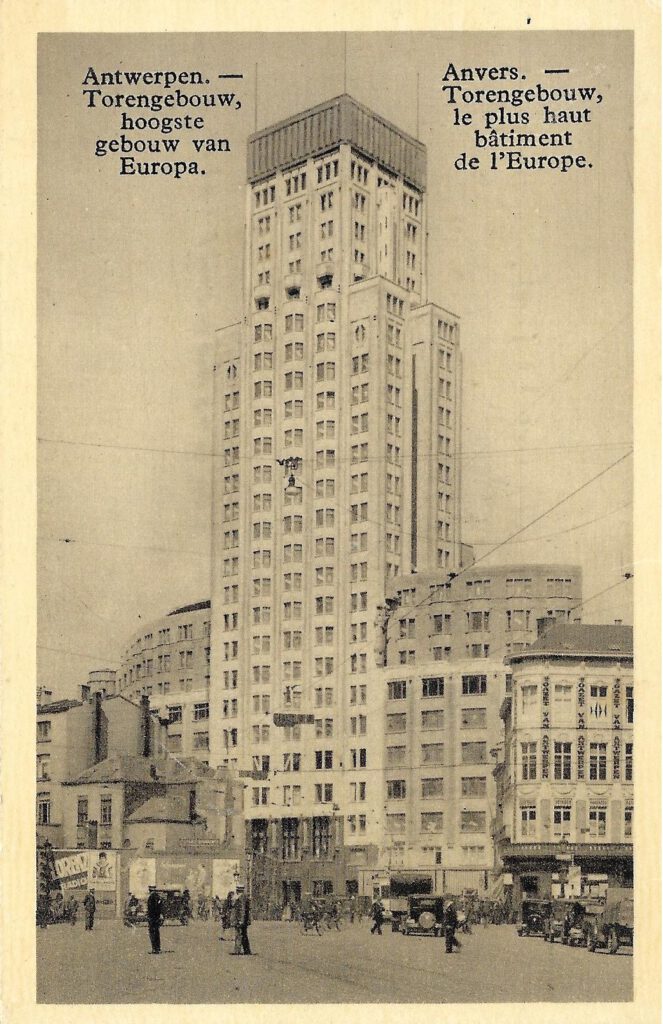Monument at Risk – The Historic Boerentoren in Antwerp
Docomomo International would like to share the letter from Docomomo Belgium, who as a national working party took initiative to compile a letter regarding the possible transformation of the historic Boerentoren building in Antwerp, Belgium. The letter can be viewed in full below:
Docomomo Belgium announces:
Monument At Risk: The ‘Boerentoren’ (‘Farmer’s Tower’) in Antwerp, Europe’s tallest 1930s residential tower
Ahead of the centenary of Belgian independence in 1930, Antwerp, an important harbour city on the River Scheldt, was elected to host a major international exhibition on ‘Colonies, Seafaring and Flemish Art’. In the run-up, in 1928, the first design for an 87.5 meter high residential tower, then the tallest in Europe, by architects Jan Vanhoenacker and Jos Smolderen was approved on the advice of city architect Emiel Van Averbeke. Because of the stake of the Farmers Union in the bank that commissioned the project, it was soon dubbed the “Farmer’s Tower”. Construction of the brick and stone-clad steel structure started in 1929. At the top was a large water tank, and just below it, on the twenty-fourth floor, a publicly accessible panorama hall, which opened in March 1932. After having attracted up to 150,000 people visitors per year, it closed to the public in the early 1970s. The building became a listed monument in 1981 based on its historic value of public interest. An additional assessment in 2019 also recognised the architectural and artistic value.

Which future for this monument?
In 2020, Fernand Huts, owner of the international logistics service provider and port operator KatoenNatie, bought the Farmer’s Tower from the KBC bank group. His stated ambition: the tower as a house for his extensive private art collection. It seemed a worthy program for this landmark, and the promised renovation was most welcome.
On the 22nd of October 2022, Mr Huts presents his vision for the tower to great media attention. To almost everyone’s surprise, the American architect Daniel Libeskind had been chosen through a self-organized limited competition without an expert jury. The news embarrassed the entire community of architects as well as most Antwerpians. Arguably, Libeskind is more renowned for his flamboyant deconstructivist style than for great empathy towards the built heritage, as striking examples the Royal Ontario Museum in Toronto, the London Metropolitan University Graduate Centre in London or the Contemporary Jewish Museum in San Francisco. But let us consider the design proposal in question.
The main concerns are due to two additions that dramatically change the tower’s appearance: a box-like volume rotated on top of the existing tower, adding about a quarter to its height, and a vertical glass conservatory hugging and overtaking the tower and its extension. Elegant is not the word that comes to mind, rather misplaced aggressiveness. Especially in the famous panorama from across the river, the tower which used to appear a younger sibling to the cathedral’s elegant spire, is transformed into a bulky and showy relative. One wonders: has the architect ever visited the location – or done any cultural-historical research – before starting to draw? Reactions in both the mainstream media and the specialized press were unanimously negative: irresponsible Dubai steel-and-glass architecture whose ambition is to cover a historic landmark with a passé one. (Image credits – The Tower of Antwerp. Highest building of Europe, picture card, courtesy Marc Dubois)
A proposal without preparation
The critique of the most influential voices was equally cutting, such as the current and former Flemish Government Architects, the director of the Flemish Architecture Institute (Vai), all architectural critics and architectural historians, as well as urban planners and architects across the country. The city council, on the other hand, remained uncharacteristically silent, perhaps hesitant to offend the important port boss and employer, as did the Flemish Heritage Agency, which is even more worrisome and hard to understand. Antwerp City Architect Christian Rapp too has kept silent to this day. Clearly, the situation is dire: established procedures were not followed, no dialogue was held with the responsible administrations to be consulted at any alteration of a listed monument. There was no preliminary discussion whatsoever. Stakeholders were not consulted, no public debate was developed, no impact analysis on the adjacent public space or the city’s skyline was presented. In short: the situation demonstrates a total lack of respect for the comprehensive historic, architectural and artistic heritage values of this Art Deco monument.
How the case will be handled further is unclear. The Alderman responsible for port, urban development, spatial planning as well as patrimony promised to organize a working group to stimulate discussion and “fine-tune” Libeskind’s design. Hopefully, the working group will do what’s right and argue why the whole process must be redone from scratch. It must be made clear to all involved that, although the tower itself is private property, the skyline of Antwerp is not.

DOCOMOMO Belgium, therefore urgently requests that the city council and the Flemish Government, especially Minister Matthias Diependaele, take the clear stand that this listed monument cannot be tampered with like this. (Image credits – Photo Boerentoren, design Daniel Liebeskind, 2022 © Katoen Natie Groep/Daniel Libeskind)
Board members DOCOMOMO Belgium
Zsuzsanna Böröcz, Véronique Boone, Marie Moors, Sabine Inghelram, Brecht Van Duppen, Sander Van Duppen, Jean-Marc Basyn, Matthias Bunneghem, Chiara Fucelli, Sébastien Charlier, Maurizio Cohen, Giulia Marino
Past Presidents DOCOMOMO Belgium
Luc Verpoest (KULeuven), Marc Dubois (KULeuven / Hon. RIBA)

